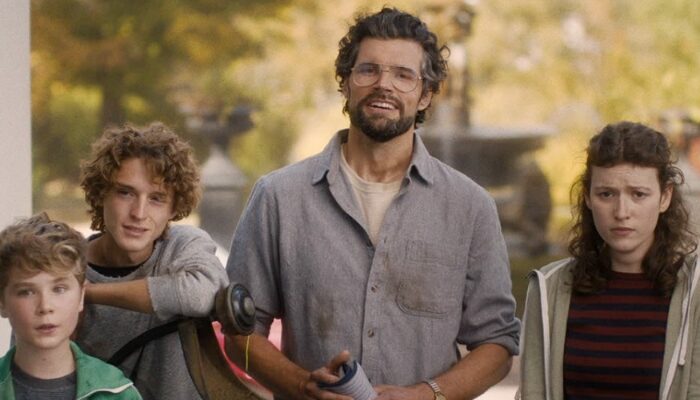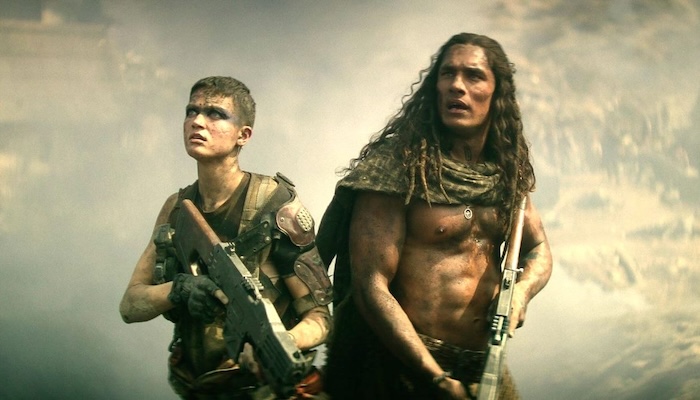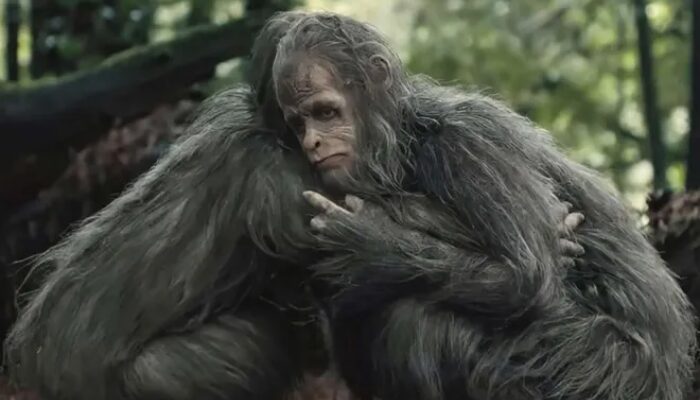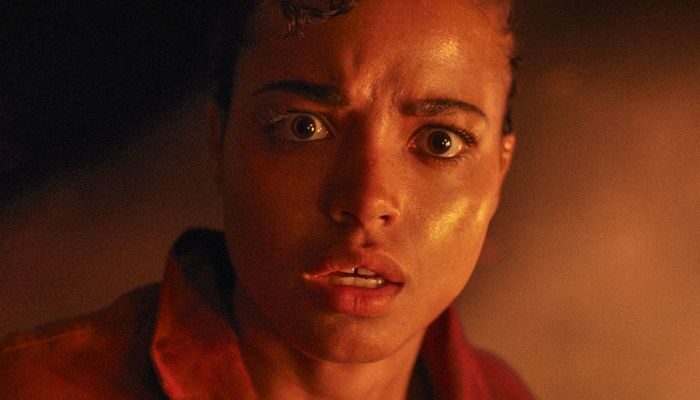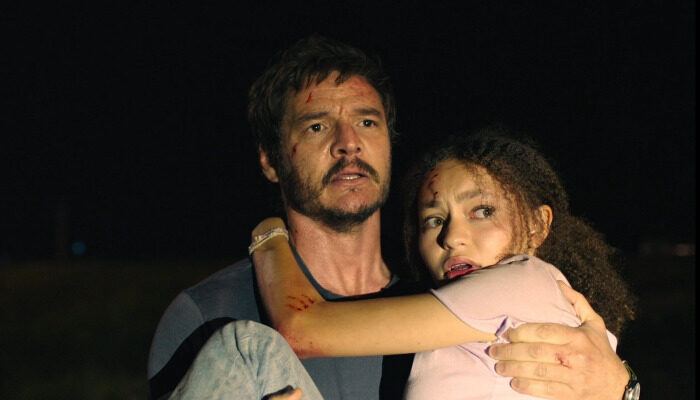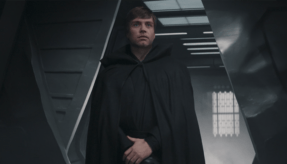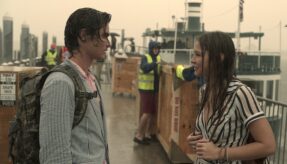TV Review: RESIDENT EVIL: Season 1, Episode 1: Welcome to New Raccoon City [Netflix]
Resident Evil Welcome to New Raccoon City Review
Netflix‘s Resident Evil: Season 1, Episode 1: Welcome to New Raccoon City TV Show Review. Welcome to New Raccoon is the opening salvo of a TV series that is potentially complete detritus. I say “potentially” because Resident Evil‘s first episode is on the low end of the quality scale and since show-writers usually set up plot strings and the main plot-line in the pilot episode, I can only assume that the remaining episodes are as poorly-written, nonsensical, and as comical as Welcome to New Raccoon City.
The first episode of Paramount+’s Halo was terrible then the series got marginally better with escalating plot-holes on top of plot-holes, not to mention huge missed narrative opportunities (a review for Halo: Season 1 is coming soon). The first episode of Apple TV+’s See was excellent, creating a familiar yet new world where entire societies lived their whole lives, fell in love, and fought wars without the ability to see.
These two pilot episode examples are offered to show that I have seen the gamut when it comes to pilot episodes for science-fiction TV series.
The Great Realization
I realized, like many I assume realized, what I was truly watching as I viewed Resident Evil‘s pilot episode. Welcome to New Raccoon City isn’t the beginning of a new chapter in great TV horror and science fiction. It’s not the realization or the essence of the Resident Evil video game series ported to the small screen (I owned the first two games). Welcome to New Raccoon City isn’t an interesting twist and new direction with Resident Evil ethos. Welcome to New Raccoon City isn’t even a great drama set in a divergent Resident Evil world.
No.
Netflix’s Resident Evil is a live-action cartoon.
When you realize this obvious fact, the characters and events in the first episode make perfect sense.
The Episode’s Comedy Sketches
Here are the laugh-out-loud moments (and resultant questions) in Welcome to New Raccoon City:
1. Teen Jade Wesker (Tamara Smart) humiliates, dominates, and ‘dog-walks’ her father all over the place, and in front of third parties, with absolutely no consequences. Example: She slaps her father’s tablet out of his hand while he is having a business meeting and her father does nothing.
2. Adult Jade Wesker (Ella Balinska) gets slammed against a car by a mutated caterpillar and cracks the tempered-glass of the windshield with the back of her head. A character mentions a potential head injury, concussion, and spinal cord damage for Jade. Agreed! Did you see and hear that slam? Next scene with Jade Wesker, no damage. None. No concussion. No spinal cord damage. No bandage. Not even a limp. Nothing. Like a cartoon character, Jade Wesker has no injuries.
3. Why would a gigantic, mutated caterpillar be asleep / hibernating underneath concrete and a building? Why is it violent? Why is a caterpillar attacking humans? Does mutation equal violence?
4. Teen Billie wants in to her father’s secret laboratory. She gets in with an iPhone recording of her father’s voice. Not an electronic keycard. Not a password. Not a fingerprint or a retina scan (Demolition Man even had the latter) or a combination of all three like in Showtime’s Homeland. No. Billie plays a phone recording and gains access, at night mind you, to a high-end, IT, medical research facility with expensive, state-or-art equipment whose research could land everyone connected to it in prison. There are no security guards. No check points. No high-level access redundancy à la like what is seen in the first act of Zero Dark Thirty. Nothing.
My apartment door has a dead-bolt on it. My apartment has a higher level of security than Umbrella.
Episode writer Andrew Dabb made Umbrella’s security a punchline because he couldn’t figure out how to get his teen characters into a richly-funded laboratory owned by an multinational conglomerate.
Dabb resorted to creating a gigantic plot-hole – on purpose – so that he could get his characters into that lab because he couldn’t to write a clever infiltration and exfiltration for teens into that building.
How about this?: A.I. White Queen “reads” the DNA of one of the teens through their expelled breath as they approach the building, quickly analyzes it, sees something interesting, and lets them in, through all of the check-points, gates, locked doors, cameras, and security guards that a normal facility of that magnitude, sophistication, and illegality would have present.
How’s that?
5. Billie opens a large cage in the Umbrella laboratory not knowing what is inside it – animal or human. She doesn’t know the state of what is inside – she is in an illegal scientific research facility (where they are researching God knows what) and the cage is locked. She doesn’t know if what is inside is: living, dead, feral, infected with a disease, or is dangerous. With all that in mind, she just opens the cage door, blithely, hoping for a TikTok, jack-in-the-box prize.
6. Everything involving the roaming, mutated, Merrie Melodies dog.
7. Teen Billie gets into a video-tapped fight with another student in the middle of the school cafeteria filled with adults and teachers and nothing happens after the fight. There are no consequences. No detention. No principal’s office. No school counselor’s office. Nothing. The fight isn’t even acknowledged by any adult as having taken place (when it happened right in front of them). When the fight video is posted online, again, nothing happens. No response from any adult, teacher, or reporter.
How does that make sense? How does any of it make sense?
8. Billie is non-violent, her current incarnation is anyway, yet Jade eggs her to get violent again and attack the girl that attacked her. Billie does the right thing, takes the high-road, and her sister, unbelievably, tries to get her to seek physical retribution.
9. Scavenger Leader informs Umbrella that he has captured adult Jade Wesker and he is flippantly killed for it.
10. Richard Baxter (Turlough Convery) shows up for Jade. Instead of first securing her in handcuffs (and leg irons), he and his men start killing people, with Jade running around free. Why didn’t Baxter wait until Scavenger Leader handed over Jade, and she was securely trussed up on the helicopter, before he started killing people? No chase that way. No chance of killing or maiming his target. Instead, misanthropic target practice, with the hero magically taking no hits because, like Storm Troopers, none of the Umbrella personnel can shoot straight. Why did everything happen in this idiotic sequence? Because episode writer Andrew Dabb wanted to shoot off a gaggle of guns in the finale of the episode.
If the capture was done intelligently and cleanly, Baxter would have: a.) taken possession of the trussed package, b.) secured her with his men, c.) covertly killed Scavenger Leader with a silenced handgun, d.) secretly loaded his corpse aboard, and e.) flown away in the Umbrella helicopter.
Only one bullet would have been fired and one gun discharged.
Dabb, obviously, didn’t want that.
The Ray of Sunshine
The aforementioned slapstick humor notwithstanding, not everyone is comedic and not every situation is comedy in Welcome to New Raccoon City.
One character sticks out as possibly being complex.
That character is Tammy Isaacs (Haseena Allie). Her intro in the cafeteria in Welcome to New Raccoon City is fantastic. The viewer is instantly transfixed by the story the meat-eater tells the vegan. Tammy is a girl not liked by other students (for obvious reasons), yet here is a new girl that she could possibly be friends with, and Tammy spits in her face (figuratively). That personality quirk and that no-friends mentality makes Tammy instantly interesting. Why does she push the new girl, a potential friend, away? What makes her act like that? Why is she happy about it?
Resident Evil‘s writers don’t even see what they accidentally created (like on the remake of ABC’s Charlie’s Angels when one of the angels is the second choice for her slot. The first choice was her sister, a killed potential angel that she replaces. That’s the real story, the interesting character – and dynamic – that should have been the root of the series) and I suspect that Tammy, the most interesting character in Resident Evil, will go unexplored as well, relegated to a side story-line in the first few episodes, soon to be discarded. Too bad. I would love to find out why she is so anti-social, aggressive, and violent with other students yet meek and subordinate around her father.
On Netflix’s Stranger Things, during Season 2, following the introduction of Billy Hargrove, the root of his serious personality problems is eventually revealed and explored. His issues and family life made him a better character and the season more compelling. That has absolutely no chance of happening on Resident Evil because, as was previously mentioned, its writers don’t know what they have with Tammy or how to exploit it to the betterment of the series’ narrative. Again, too bad.
The Lost Hope
When Netflix publicized the two timeline story for Resident Evil, I was excited. I admit it. I was looking forward to seeing that plot synopsis realized on-screen in grisly, sci-horror fashion. I wanted to see a fresh, original, and invigorating new branch in the Resident Evil universe.
Then I saw the pilot episode.
It’s embarrassing.
But if it’s secretly a live-action cartoon, like I suspect, then it’s hilarious.
Leave your thoughts on this Resident Evil Welcome to New Raccoon City review and this episode of Resident Evil below in the comments section. Readers seeking to support this type of content can visit our Patreon Page and become one of FilmBook’s patrons. Readers seeking more TV show reviews can visit our TV Show Review Page, our TV Show Review Twitter Page, and our TV Show Review Facebook Page. Want up-to-the-minute notification? FilmBook staff members publish articles by Email, Twitter, Facebook, Instagram, Tumblr, Pinterest, Reddit, Telegram, and Flipboard.
Related Articles
FilmBook's Newsletter
Subscribe to FilmBook’s Daily Newsletter for the latest news!

